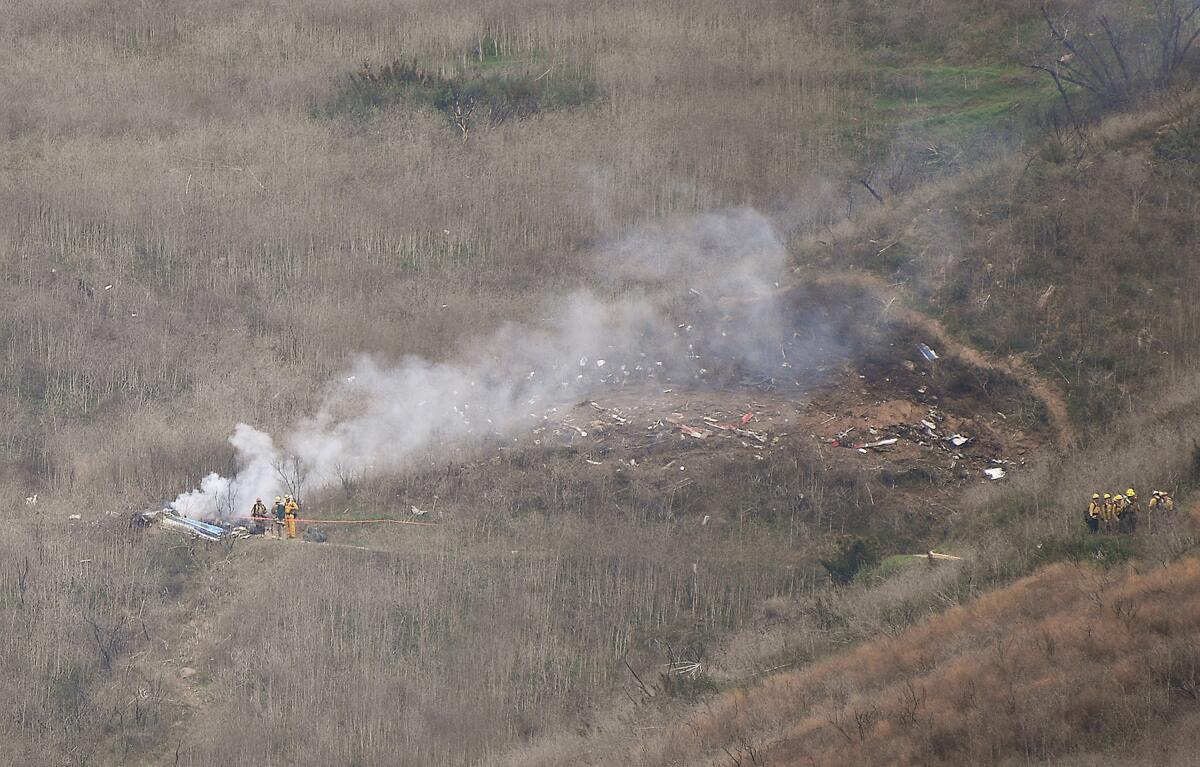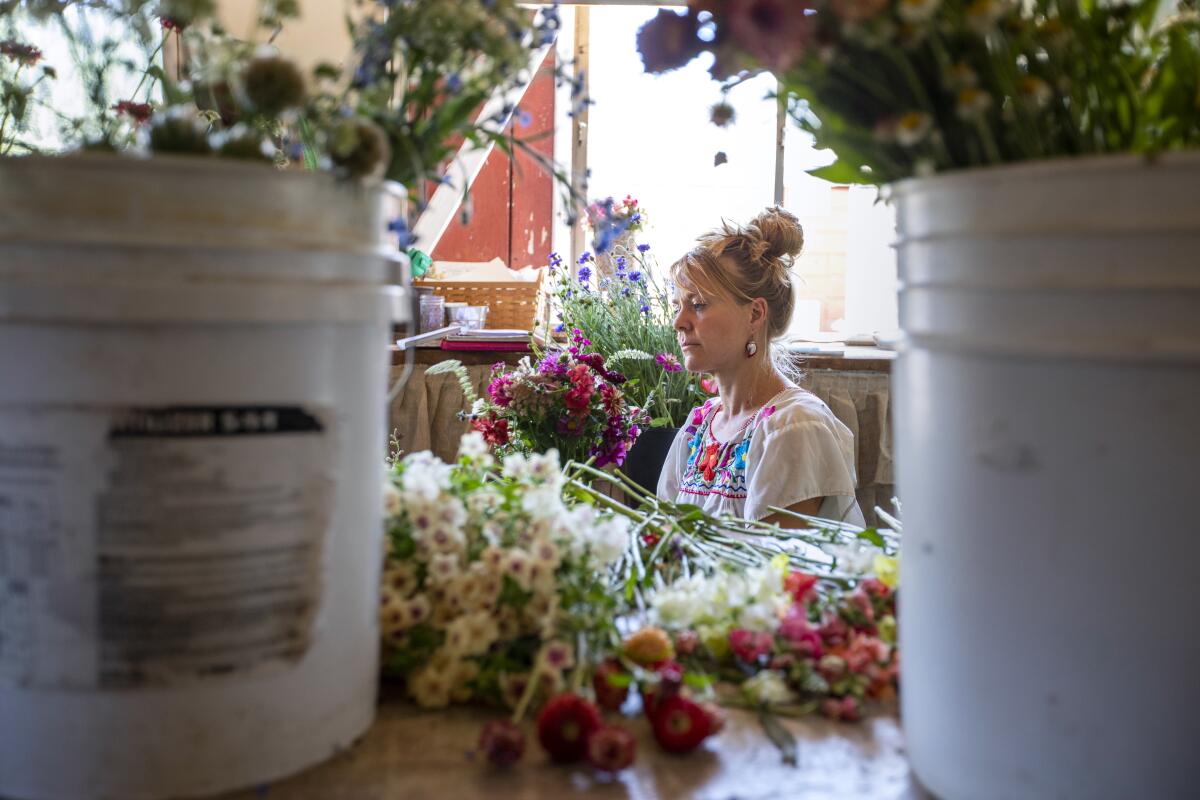Another day, another version of events in the trial over the Kobe crash photos

- Share via
Good morning, and welcome to the Essential California newsletter. It’s Tuesday, Aug. 16. I’m Jonah Valdez, a reporting fellow on the Fast Break desk.
The day Lakers legend Kobe Bryant, his daughter Gianna and seven others died in a helicopter crash, I took a Lyft from my Koreatown apartment to Staples Center, where I cried along with thousands of other mourners.
I recall intimate conversations with strangers in which we processed our shock at the brutal manner in which he and the others died. We imagined a nightmare, horrific scenes of their last moments and what remained afterward.
[Read: “In trial over Bryant crash photos, contradictions, denials and ‘memory issues” in The Times.]
Vanessa Bryant, Kobe’s wife, didn’t want such tragic images of her family to become public. In the moments after the crash, she pleaded with L.A. County Sheriff Alex Villanueva to make sure no one took photographs of her loved ones, imploring him to secure the area, according to the reporting of my colleague Alene Tchekmedyian, a Times reporter who covers the Sheriff’s Department.
Villanueva made his promise, but that same day, closeup pictures were snapped of the carnage in the Calabasas hillside and later texted and Airdropped, and sheriff’s deputies and county firefighters were caught up in the scandal.
Tchekmedyian’s reporting would later uncover that those photos of the deceased were flashed from a sheriff’s deputy’s phone screen to a bartender in Norwalk, sparking public outcry. Later, Vanessa Bryant and Christopher Chester, who also lost his spouse and a child in the crash, sued the county over how far the images had spread and the pain they had brought to families who lost loved ones.
The trial in the lawsuit, which began last week, continued Monday with testimony from a former county fire captain and two sheriff’s deputies. Tchekmedyian and Michael Finnegan, another Times reporter who is covering the trial, told me that Bryant’s and Chester’s lawyers seized on inconsistencies in the testimony of the first responders.
In previous interviews with investigators and depositions, the three county first responders admitted to seeing photos of the human remains from the crash site. But during Monday’s questioning, they downplayed exactly how much they had seen.
During questioning by Bryant’s attorney, retired L.A. County Fire Capt. Brian Jordan said, “I do not remember taking the pictures,” then stood up and walked off the witness stand, announcing that he needed a break. He did this several times during his testimony.
Witnesses often become emotional during testimony or need to pause for a break or water, said longtime reporter Finnegan, who was in the courtroom Monday morning.
But for a witness to stand and leave multiple times during the course of their testimony — “I’ve never seen that before,” he said.
Despite the unexpected behavior on the witness stand, it was contradictions within testimony — an inability to remember walking the crash scene, no memory of having taken photos — that were the focus of attorneys, said Finnegan.
“I think it adds to this picture of ‘Somebody is not telling the truth,’” Finnegan said. “And so it’ll be interesting to see how the jury weighs all of these contradictions and tries to figure out what is true. What do they conclude the truth is? Who do they find credible?”
The county has argued that first responders had legitimate reasons to take or receive the photos, such as to determine the size of the crash site and decide what resources were needed.
Although the trial is focusing on the extent to which the sharing of the photos has caused distress to Bryant and Chester, its outcome has larger implications.
As Tchekmedyian reported, Bryant’s attorney continued to assert their stance that there is a long-standing practice in law enforcement in the county of taking and sharing gruesome photos from crime or accident scenes, especially when celebrities are involved — something the county denies. The Bryant case and Tchekmedyian’s reporting on the crash-site photos spurred a 2020 state law, which made such practices a misdemeanor.
An earlier witness in the trial said “death books” are a real problem.
“I think,” Finnegan said, “this sort of universal right to dignity is what’s being litigated here.”
[Read: “In trial over Bryant crash photos, contradictions, denials and ‘memory issues” in The Times.]
Sign up for Essential California
The most important California stories and recommendations in your inbox every morning.
You may occasionally receive promotional content from the Los Angeles Times.
And now, here’s what’s happening across California:
Note: Some of the sites we link to may limit the number of stories you can access without subscribing.

The states that rely on the Colorado River as a water source, including California, had two months to come up with a plan to reduce water use. Yet after the two months, these Western states still don’t have a plan. In short, it’s a mess, full of disagreements, animosity and “irreconcilable differences among the states” that may lead to federal intervention and battles in court. But, as one water official put it, the conflicts boil down to a simple, existential point: “Everybody needs to commit to a significant sacrifice in order to avoid having nothing at all.” Los Angeles Times
Some small and rural communities across California have been forced to rely on bottled water and water hauled in from other areas. Their supplies have been drained amid a drying climate across the state. A map shows where these parched communities are and how many others are at risk of following suit. San Francisco Chronicle
L.A. STORIES
A second attempt to recall L.A. County Dist. Atty. George Gascón has failed. The campaign was meant to force the progressive D.A. into a recall election but, like the first attempt, fell short of its signatures goal, this time by more than 40,000. Detractors were driven by their criticism of Gascón’s reforms, which they say have driven up crime. Supporters maintain that the reforms have made communities safer and more equitable. Los Angeles Times

Classes are back in session, and with a new year comes hope for normalcy. Some school districts relaxed COVID-19 safety restrictions. Others bolstered security in response to the mass shooting at an elementary school in Uvalde, Texas. Officials continue to downplay the possible threat of the spread of monkeypox among children. Take a look at how life is playing out on campuses across California. Los Angeles Times
If you’ve gone apartment hunting over the last few months, you know how tough the market is, whether it be a lack of options or rents that surpass your budget. Although it’s been known that California has among the highest rents in the U.S., the Golden State cities that top the list in a new report may surprise you. After Palo Alto, which is third, come the L.A. County cities of Glendale and Santa Monica, which carry average rents of $4,472 and $4,357, respectively. We dig in to find out why. Los Angeles Times
Support our journalism
IMMIGRATION AND THE BORDER
Fiery roadblocks lighted by cartel groups in the Mexican border town of Tijuana effectively shut down huge swaths of the city, as many stayed home, fearing violence. Even so, only one person was injured throughout the weekend. Wait times at the San Ysidro port of entry were reduced from the usual multiple hours to 10 or 15 minutes. Although life is resuming, one expert commented that the cartel’s actions reminded the region that it is organized crime that calls the shots when it comes to security in Baja California. Los Angeles Times
The “Remain in Mexico” immigration policy, a vestige of the Trump presidency, came to an end last week. For some, it brought immediate relief. It’s also cause for confusion among those in the legal immigration system. Still, the end of the Trump-era policy is set to bring hundreds of asylum seekers out of Tijuana and into the U.S., where they can live as they await their court dates. San Diego Union-Tribune
If you left your home, what would you carry with you? Two decades after the U.S.-led invasion of Afghanistan, the Taliban arrived in Kabul last year, forcing thousands of people, many of whom embraced Western ideals, to flee. Although they had to leave most of their possessions behind, what they took with them carried deep personal value, connecting them to their homeland. Here are the stories of four who wound up in Paris and the objects they carried to remember. Los Angeles Times
POLITICS AND GOVERNMENT
A new California program provides two meals a day to public school students. The Universal Meals Program provides breakfast and lunch to students in transitional kindergarten through 12th grade, regardless of their parents’ income. The Los Angeles Unified School District is taking it a step further, providing three meals a day. Los Angeles Times
Our daily news podcast
If you’re a fan of this newsletter, you’ll love our daily podcast “The Times,” hosted every weekday by columnist Gustavo Arellano, along with reporters from across our newsroom. Go beyond the headlines. Download and listen on our App, subscribe on Apple Podcasts and follow on Spotify.
HEALTH AND THE ENVIRONMENT
Even with a drought and unprecedented heat, the threat of a “megaflood” looms larger than ever for California. A recent UCLA study suggested that rising temperatures due to climate change allow the atmosphere to absorb and store more moisture. This results in either extreme drought or a huge release of water that could submerge cities such as Stockton, Fresno and parts of Los Angeles, displacing up to 10 million people and causing $1 trillion in damage, which would be the largest disaster in world history. Los Angeles Times

The Dixie fire destroyed their town last summer. But from the ashes, one family’s flower business has bloomed. Started in a yard that was spared during the fire, Kjessie Essue’s business continues to grow, delivering flower arrangements to a burn-scarred Northern California community. Los Angeles Times
CALIFORNIA CULTURE
One-third of Americans older than 30 have returned to their childhood homes, many chasing the place to which they have tied their identities. Times reporter Melody Gutierrez did just that earlier this year, returning to a now-vacant homestead in a small California desert community, decades after she and her family abandoned it. Read what she found. Los Angeles Times
Love, fiddle-leaf fig, a bustling plant store. Such is the progression of Sarah and Tadeh Bazik, owners of SarahCotta Plants, which opened its doors in Glendale in the summer of 2020, amid the early months of the COVID-19 pandemic. Los Angeles Times
Free online games
Get our free daily crossword puzzle, sudoku, word search and arcade games in our game center at latimes.com/games.
CALIFORNIA ALMANAC
Los Angeles: sunny, 90. San Diego: some clouds, then sunny, 79 . San Francisco: mostly sunny with a few clouds, 73. San Jose: sunny, 91. Fresno: sunny, 107. Sacramento: mostly sunny, 107.
AND FINALLY
Today’s California memory comes from Cecile Landry:
On Feb. 9, 1971, I was just stepping into the bathtub in Sun Valley when the Sylmar earthquake occurred. I was pregnant [with] my third child. I screamed as the water in the tub sloshed back and forth, and I heard a crash from the kitchen. My husband flew up the stairs and grabbed our two older children, ages 4 and 7, one under each arm, and flew back down the stairs. The four of us huddled in the hallway door frames until the shaking stopped. It seemed to take forever. Our only damage was a bottle of bourbon that crashed and the chimney’s separation from the house.
If you have a memory or story about the Golden State, share it with us. (Please keep your story to 100 words.)
Please let us know what we can do to make this newsletter more useful to you. Send comments to essentialcalifornia@latimes.com.
Sign up for Essential California
The most important California stories and recommendations in your inbox every morning.
You may occasionally receive promotional content from the Los Angeles Times.







